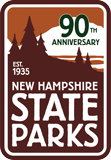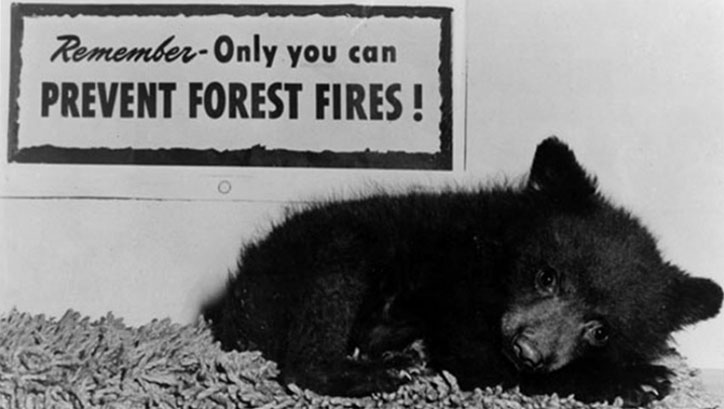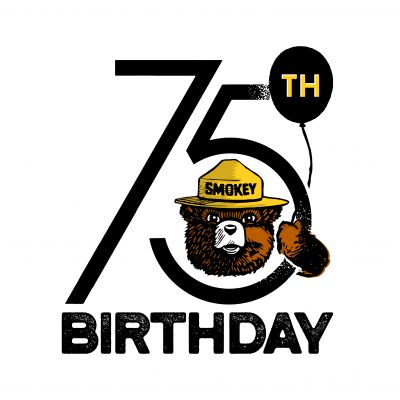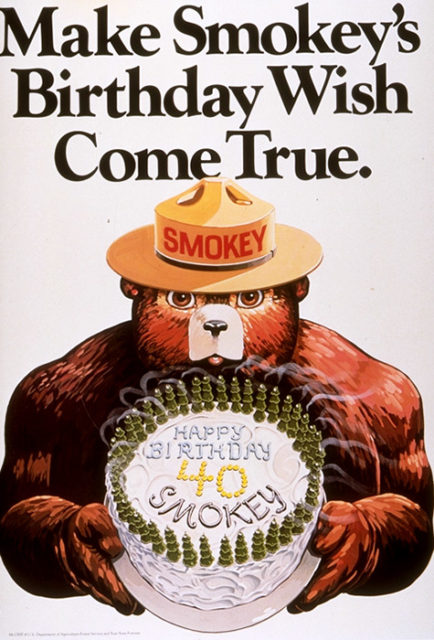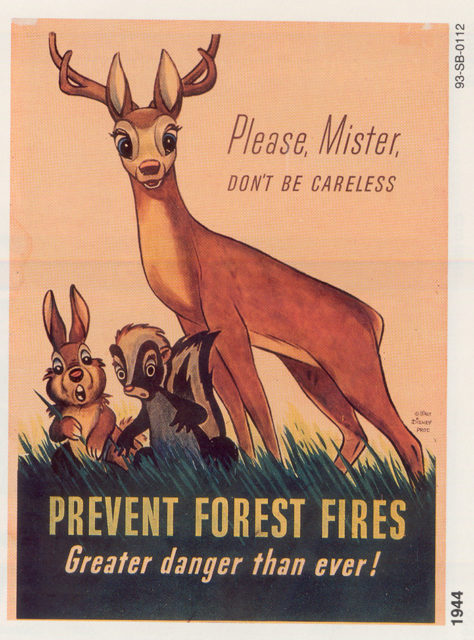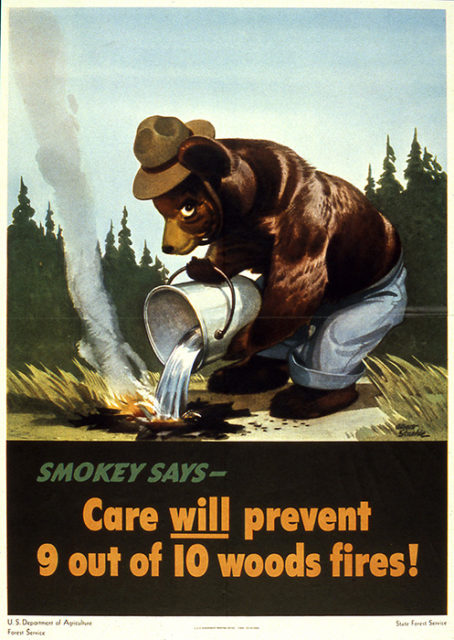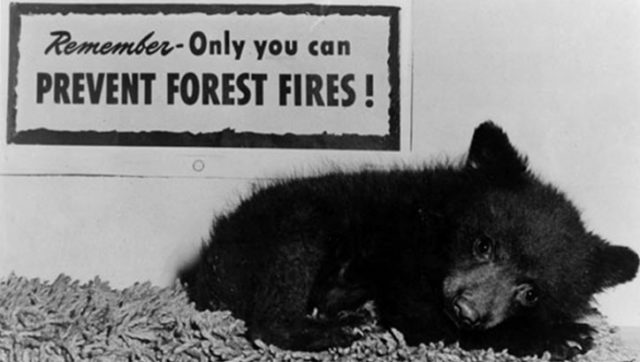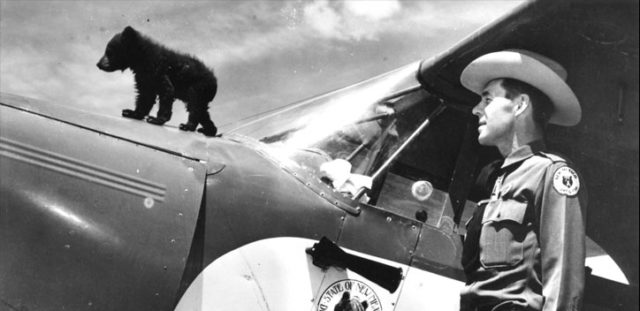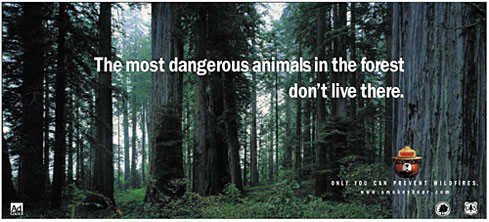By Sarah Sherwood, SCA Franconia Notch State Park Interpretive Ranger and NH Corps Member
You don’t need to be an avid camper or outdoorsman to be familiar with the forest’s favorite bear. This year, America’s loveable icon Smokey Bear is turning the milestone age of 75. In celebration of his legacy, let’s take a moment to reminisce on his humble beginnings and his valuable lessons over the years.
The Smokey Bear Wildfire Prevention campaign was launched in 1944 and is now ranked as the “longest-running public service advertising campaign in U.S. history” (smokeybear.com). It began during World War II in response to fears that attacks by submarines on the California coast would ignite fires in the hills. Most experienced firefighters were deployed during the war, leaving concerns about wildfires in the hands of community. The idea arose that a prevention campaign could be a way to fight fires before they began. The Forest Service created the Cooperative Forest Fire Prevention (CFFP) program and advertised it as a way to help win the war.
Disney’s film “Bambi” came out in 1942, sparking affection for adorable forest wildlife. The CFFP campaign was loaned the Disney characters’ likeness for one year’s worth of posters. Using the public’s love for animals as a tool to encourage fire safety worked wonders, so the program decided they needed a cuddly symbol of their own. The bear was selected for its powerful yet charming image and in 1944 artist Albert Staehle created the first ever Smokey Bear poster, showing a bear pouring a bucket of water on a campfire.
In 1950, the movement found its face in a bear cub orphaned by a wildfire. The fire broke out in the Capitan Mountains of New Mexico and swept through the forest powered by strong winds. Crews comprised of forest rangers and game wardens from New Mexico and Texas responded and tried to control the blaze while protecting themselves against the quickly spreading flames. Dozens of firefighters had to resort to lying facedown on a rockslide to survive.
Nearby, a lone bear cub was also struggling to escape the inferno. He was found by responders clinging to a charred tree, alive but with burns on his paws and hind legs. A local rancher on the crew offered to take in the little bear after he and another ranger flew the young cub to Santa Fe to get treatment for his burns.
It didn’t take long before the cub’s survival story spread throughout New Mexico and beyond, attracting the attention of the United Press and Associated Press. Fans across the country wrote to inquire about the bear’s health. New Mexico’s state game warden eventually contacted the head of the Forest Service, offering up the cub as a mascot – with the condition that he be used exclusively as an advocate for conservation and wildfire prevention. The Forest Service readily agreed, and the cub became the living incarnation of the Smokey Bear campaign.
At his new home at the National Zoo in Washington D.C., Smokey was so beloved by the public that he required his own zip code for deliveries of honey and letters. He lived a long life and after his death in 1976 his body was returned to Smokey Bear Historical Park in Capitan, New Mexico, where he is honored to this day.
One curious twist in Smokey Bear’s legacy is the confusion surrounding his name. Steve Nelson and Jack Rollins’ 1952 wrote a song in which they added a “the” between “Smokey” and “Bear” for the sake of the song’s rhythm. The modification stuck and most people know today him as “Smokey the Bear,” despite his name always officially being “Smokey Bear.”

This year, Smokey’s historic crusade is being celebrated nationwide for its 75th anniversary. In Franconia Notch State Park, a birthday celebration was thrown on August 15th. Cannon Mountain hosted a variety of events, from a chance to touch a firetruck to rides in a Smokey hot air balloon. Families enjoyed cake, live music, games and displays, and free Tram rides. Cannon is a known home to several black bears of its own, who did not show up to the party. We can only assume they celebrated in private by enjoying their well-protected and fire-free environment on the mountain.
Smokey put an adorable face on an important campaign, one that has only become more relevant with time – in 2018 alone, 89% of wildfires were caused by humans. At smokeybear.com, you can learn campfire how-to’s, from picking your spot to fully extinguishing the flames. There is also advice for backyard debris burning and how to prep your home for a wildfire. Smokey’s legacy shouldn’t be remembered merely as a catchy ad campaign; to truly honor and celebrate America’s favorite bear, we all must be responsible fire stewards. As Smokey says: only YOU can prevent wildfires!
- Make sure you are at a site that allows campfires.
- Make sure there are no burn bans and it’s not too windy.
- Dig a pit away from overhanging branches.
- Circle the pit with rocks.
- Clear a 10-foot area around the pit down to the dirt, removing anything that could catch on fire.
- Stack extra wood upwind and away from fire.
- After lighting, throw the match into the fire.
- Never leave a campfire unattended; an adult should supervise the campfire at all times.
- Keep a bucket of water and shovel nearby.
- Never put anything but wood into the fire.
- Do not pull sticks out of the fire.
- Do not sit on the fire ring or rocks around the campfire. They will heat up quickly and they’ll stay hot for a long time.
- When it’s time to put the fire out, dump lots of water on it, stir it with a shovel, then dump more water on it. Make sure it is COLD before leaving the campsite. If it’s too hot to touch, it’s too hot to leave!
